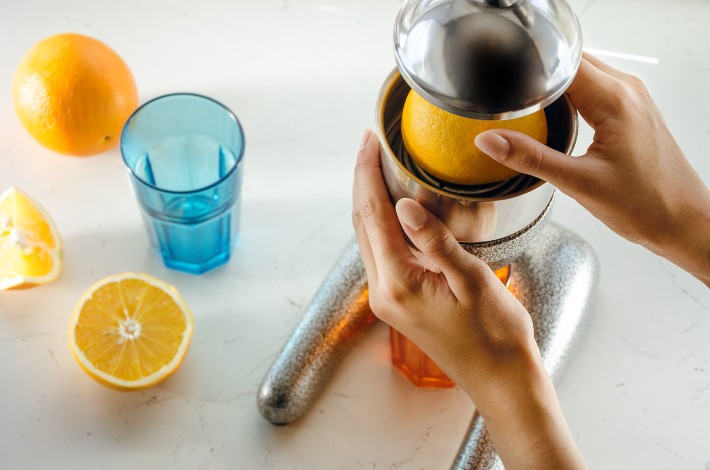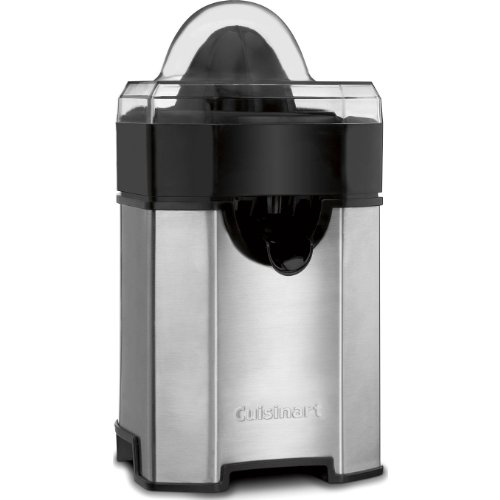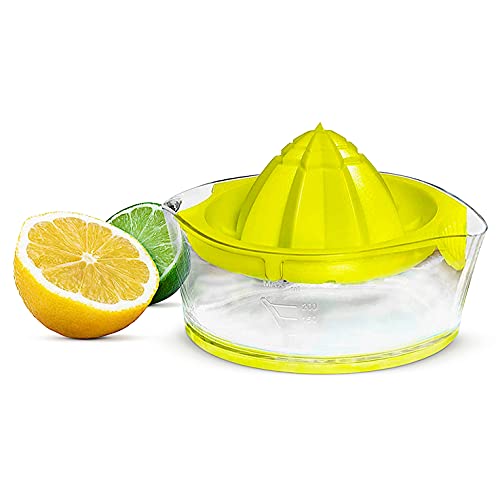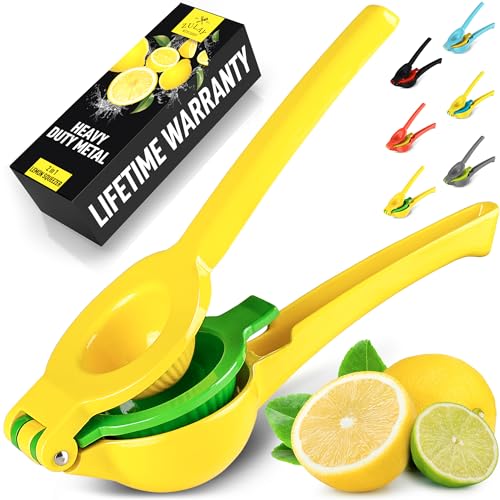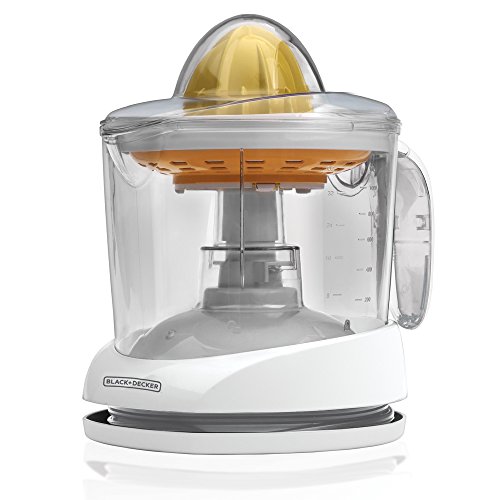- Recipes
- Breakfast Brunch
- Appetizers Snacks
- Lunch /Dinner
- Side Dishes
- Desserts
- Drinks
- Sauces & Stuff
- Collections
Learn & WatchOur content is meticulously curated through independent research, testing, reviews, and AI-driven recommendations, all designed to present you with the finest product choices. When you make a purchase through our links, it could result in us earning a commission.The Best Citrus Juicer of 2024
Last updated: 9 May 2024
Indulge in the invigorating burst of flavor from citrus fruits like lemon, lime, grapefruit, and oranges. These vibrant gems elevate everything from classic guacamole to sizzling quesadillas with their refreshing zest. Yet, extracting their precious juice by hand can be messy and inefficient, leaving behind pulpy residues and potential bitterness. That's where a citrus juicer comes into play. With these handy gadgets, you can extract every last drop of juice from any citrus fruit, ensuring maximum flavor for your dishes or delightful cocktails. Embrace the convenience of a quality citrus juicer, with brands like Cuisinart offering the best citrus juicer for innovation and reliability.
Our Top Picks For Citrus Juicers
- Best Overall: Cuisinart Citrus Juicer Shop Now ➔
- Convenient Design: ARK Reamer Citrus Juicer Shop Now ➔
- Most Compact: Zulay Kitchen Citrus Juicer Shop Now ➔
- Best Performance: Black+Decker Citrus Juicer Shop Now ➔
- Most Durable: Pohl Schmitt Citrus Juicer Shop Now ➔
- Most Reliable: Eurolux Citrus Juicer Shop Now ➔
View all ContentsThe Best Citrus Juicers
Best Overall
The Cuisinart citrus juicer is most certainly an all-rounder product the market has to offer. Its universal reamer can extract juice from almost any type of citrus fruit. There are three pulp settings — low, medium, and high — allowing you to decide how much pulp you would like to scrape out of the fruit shell. Its reamer can rotate in both directions automatically once the pressure is removed and reapplied.
This citrus juicer also has a final spin feature that you can use to extract juice from the pulp left behind after closing the plastic lid. Since it’s reinforced with an extra-long snap-up spout, it allows the juice to flow directly into the glass placed under it with no drips on the tabletop. On top of everything, the entire body covering the motor has a stainless steel housing for added durability, making this citrus juicer the top choice on our list.
Pros
- Can prevent drips
- Dishwasher safe parts
- Final-spin feature extracts more juice
Cons
- May be too bulky for some
Convenient Design
The ARK Reamer citrus juicer is an ideal kitchen gadget for those who want to enjoy freshly-squeezed juice from oranges, lemons, and limes. This manual juicer uses a convenient design that allows users to extract as much juice from the fruit as possible, with minimal effort and clear measurements. The powerful reamer allows for maximum juicing and captures seeds and pulp while allowing the fast flow of juices.
The squeezer is made of BPA-free plastic and high-quality materials that are food-safe, so you can trust that the juice you get is not contaminated. Clean-up is a breeze since the manual juicer press has no moving parts, meaning there are no complicated parts to scrub or difficult cracks and crevices to worry about. Plus, it comes with a non-slip base that ensures it stays stationary while in use.
Pros
- Gets all the juice out
- Attractive and durable design
- Easy to use and clean
Cons
- Size is too small for larger fruits
Most Compact
The Zulay Kitchen citrus juicer is the easiest to use; all you have to do is cut the citrus fruit into two pieces, keep one half in its bowl-shaped mold, and press the handles. The application of manual pressure will squeeze the pulp completely to extract the maximum amount of juice from the fruit. It’s designed so you can extract fresh juice from limes, lemons, limequats, Lisbon lemons, Tahiti limes, and more. Since it has an intermediate strainer, you won’t have to worry about the seeds in the liquid extract. This citrus juicer’s handles are made from sturdy aluminum so that you can press them with maximum force. With the help of the smooth-working hinge, the opening and closing of this citrus squeezer are much more convenient. For cleaning, simply hang it on the dishwasher’s top rack or place it under running tap water.
Pros
- Suitable for small and large citrus fruits
- Sturdy and heavy duty bowls
- Features a seed filter
Cons
- May not be powerful enough for some
Best Performance
The Black+Decker citrus juicer is known for its excellent performance and amazing construction. It comes with self-reversing cones of different sizes for small and larger citrus fruits. As they can reverse their rotating direction when releasing and reapplying pressure, you will get all of the juice from one-half of the fruit. Additionally, this juicer is reinforced with three pulp settings to give you the freedom of choosing whether you want less or more pulp. The juice container is made from transparent plastic and has a scale marked along its wall to indicate the juice’s volume. It also has a conical spout structure for easy pouring of the fresh juice into a glass without any drip.
Pros
- Easy to store
- Two different sized cones
- Adjustable pulp control
Cons
- May be too loud for some
Most Durable
If you are in search of an electric citrus juicer with a great design, the Pohl Schmitt citrus juicer is perfect for you. It comes with a large container with a total capacity of 1 liter that will suffice for the need for fresh fruit juice for a gathering or a party. It also features a spout design to easily pour the juice into glasses with zero waste. To help you extract all of the juice from both small and large citrus fruits, this pack comprises two different-sized, self-reversing cones. Thanks to the fixed filter, you can control the pulp volume you want in the juice. Additionally, its anti-slip base and handle will prevent the juicer from moving unexpectedly and slipping out of your grip.
Pros
- Large capacity and removable juice container
- Easy to clean and dishwasher safe
- Features non-slip feet and a protective cover
Cons
- Does not come with a cord wrapper
Most Reliable
The Eurolux citrus juicer comes with a universal reamer with deep ridges on its outer surface. Therefore, you can extract juice from any citrus fruit, while the ridges will ensure that not a single drop of juice is left behind. For switching on the motor, press down the handle, and for turning it off, release the pressure. Additionally, its handle has a soft rubber covering for better grip. This juicer is also reinforced with a filter to trap any seeds or pulp. Since it comes with a locking spout, it will automatically pour the juice into a glass when pushed down. If you want to preserve the juice in the container, simply push up the spout.
Pros
- Powerful and effective motor
- Automatic one-touch operation
- Fits most fruit shapes and sizes
Cons
- Cannot hold a high volume of juice
Finding the Best Citrus Juicer: A Buying Guide
When it comes to citrus juicers, your primary concern is to extract the maximum amount of juice from citrus fruits, regardless of their type or size. But there are different types of juicers on the market, of which some have the best performance while others have the most appealing designs. Therefore, choosing the best product among them is not an easy task. So, we have created a full buying guide to help you get the most out of your investment.
Types of Citrus Juicers
There are two types of citrus juicers on the market: manual squeezers and motorized juicers. As a result, their working method is also different, which we have explained in the below sections.
Manual citrus squeezer
This squeezer has a bowl-shaped hollow structure in a manual squeezer where you have to place half of the citrus fruit in an inverted manner. Once done, press both handles with as much force as you can. Make sure that you are using a large bowl for collecting the juice because it will drip from the sides of the squeezer. Subsequently, open it, adjust the position of the fruit, and again compress the handles. This will help you extract the maximum juice out of the fruit pulp. If you’re looking to squeeze some limes for a margarita now and again, a simple manual squeezer may be all you need.
Motorized citrus juicer
Another type of citrus juicer you can find on the market is one reinforced with a motor. It has a reamer or cone that will scrape the pulp from the citrus fruit. You need to place the flat surface of the fruit over the conical tip of the reamer and then press it down slowly. This will activate the motor, enabling the cone to rotate automatically. As it rotates, the ridges in the reamer will squeeze out the juice from the pulp. On releasing the pressure, the motor will automatically stop its operation.
Cookbook author and food blogger Jessica Fisher has used both a manual and electric juicer. She says that “[f]or quick jobs involving 1 to 2 oranges (or other citrus fruits), I use the manual. If I’m juicing many lemons to freeze the juice, I use my electric citrus juicer.” Consider what the primary use of your juicer will be before determining which option you want.
Features to Look for When Shopping for a Citrus Juicer
Container volume
While choosing a citrus juicer, check the volume of its juice container. Some products have a flat and shallow containers. Therefore, they won’t be able to hold much juice, which is why they are ideal for regular use. However, if you want to use the juicer to make fresh lemonades or citrus cocktails at a party, you need to go for a product with a large juice container. Usually, these containers have a volume of 1 liter that will be enough to make multiple glasses of lemonades or drinks.
Reamer size
Some citrus juicers are reinforced with universal reamers so that you can extract juice from different fruits having any size without extra effort. Such a reamer is designed to scrape out the pulp and squeeze it for extracting juice from a wide range of citrus fruits. However, there are products where you will get two different-sized cones. The smaller cone is best suited for extracting juice from small fruits like lemons, lime, and more. On the contrary, if you want orange juice or grapefruit juice, you need to replace the smaller cone with the larger one.
Pulp settings
A citrus juicer typically comes with three different pulp settings: low, medium, and high. If you want to use the fruit pulp for some other dishes, you need to set the appliance at a low setting. But in case you want to squeeze out the juice from all the fruit pulp, make sure to keep the juicer at a high pulp setting.
Material
The cones or reamers, sieves, and fruit containers are made from plastic, meaning they’re easier to clean in dishwashers. They’re also light and won’t break if you accidentally drop them on hard surfaces like the floor. Moreover, most products have stainless steel housing to ensure that the motor is protected from damage. This material is more durable and can withstand a high amount of wear and tear without succumbing to the damages.
Top cover
In some juicers, the top lid is mainly used to cover the reamer and sieve so that they don’t get damaged from dust and dirt. However, there are a few products where the lid helps extract all the juices from the pulp stuck between the ridges of the reamer.
Base
A citrus juicer often comes with anti-slip bases to prevent the appliance from moving unexpectedly from its position while you are pressing the fruit onto the reamer. It would also be better to get a juicer with suction cups at the base because they will prevent marring spots on your kitchen countertop or island top.
Different Types of Spouts Found in Citrus Juicers
To make sure that you can pour the liquid easily into a glass from the juicer’s container, most products are reinforced with a spout. This conical projection makes sure all the juice is transferred to the glass with no wastage. However, there are two types of spouts: snap-up and built-in spouts.
In some products, you will find that the juice container’s edge is designed as a built-in spout with a conical lip so that you can pour down the liquid without creating a mess. The snap-up spouts are built outside the product and almost behave as dispensers. If you push them down, the juice will flow freely from the container to the glass kept under it. And when you don’t want to use the juice, simply push up the spout, and it will prevent any drip.
Citrus Juicers vs. Regular Fruit Juicers
There are considerable differences between citrus juicers and regular fruit juicers that you should know before deciding which one to purchase.
- A citrus fruit juicer has a reamer with sharp ridges that will scrape the pulp from the fruit. In regular juicers, blades are there at the bottom.
- The citrus fruit juicer is specifically made to squeeze out the juice from citrus fruit pulp. On the contrary, other juicers grind and crush the food particles and then produce the juice.
- You won’t have to use a sieve with the citrus juicer, but you need to strain the juice separately if you use regular juice-making appliances.
People Also Asked
How can I clean the citrus juicer?
You can clean the cones or reamers, juice containers, and sieves using water in the kitchen sink or dishwasher if they are dishwasher-safe.
Why do the reamers rotate in opposite directions in a citrus juicer?
The reamers rotate clockwise and counterclockwise in most citrus juicers to ensure that maximum juice can be extracted from the pulp.
Do I need to plug the citrus juicer into an electric outlet?
If you have a motorized citrus juicer, you need to plug it into the electric outlet. Once you switch on the power, the motor will start working to extract the citrus juice.
Can I juice non-citrus fruits with a citrus juicer?
Citrus juicers are specifically designed for citrus fruits, i.e. lemons, limes, oranges, etc. If you wish to juice something else in your citrus juicer, it must have a soft core like an orange, produce juice when pressed, and be circular. Pomegranates, for example, fit all of these qualities.
How can I increase the amount of juice from my citrus fruits?
Roll your fruits before you juice them. This is a simple trick that works. Merely roll the fruit between your palm and a flat surface before you cut, and then juice your fruit.
Article Contributors
Read More About Cuisine Review Team HereThe Cuisine Review Team’s in-depth guides and product reviews are designed to help you pick the best products for a beautiful and professional-grade kitchen and dining room.
Cuisine at Home is reader-supported: When you buy through links on our site, we may earn an affiliate commission. Artificial Intelligence (large language models) may have been used in the research and creation of the content.
Please contact aimperiapt@gmail.com for all inquiries regarding articles or product testing.
Related Articles
